WhatsApp marketing is a type of messenger marketing, which implies promoting a brand through WhatsApp. This channel helps brands reach an enormous audience, build strong relationships with customers, and increase sales. With SendPulse chatbots, you can convert more leads into customers and provide 24/7 client support.
In this video, Alex, a marketer at SendPulse, explains how to boost your marketing efforts on WhatsApp.
Why Should You Use WhatsApp Marketing for Your Business?
WhatsApp is the most popular messaging platform in the world. In 2020, its audience has grown up to 2 billion active users monthly. This marketing channel is a must-have for businesses that want to connect with audiences in developing countries. For instance, there are 340 million monthly WhatsApp users in India and almost 100 million in Brazil. However, the platform is also an excellent choice for promotions in the US market – 68 million Americans access WhatsApp at least once a month.
WhatsApp marketing allows you to stay in touch with your customers – more than half of WhatsApp users check the app every day. Better yet, you can be sure they will get your offers, as text messages have a 98% open rate.
The last point is that your customers love this communication channel. They trust brands with chat apps more – 53% of people say they would buy from companies they can reach via chat.
However, there are more reasons to implement WhatsApp in your marketing strategy. Read on to learn a few more benefits of this marketing channel.
Learn more about WhatsApp marketing on our blog
Benefits of WhatsApp Marketing for Your Business
- Profound relationships with customers
- Higher conversion rate
- Better sales
- Lower cost of marketing
Using messengers is a golden opportunity to improve your marketing strategy. There are four positive outcomes of using WhatsApp for your business promotion.
Profound relationships with customers
Over 55% of people feel more connected to a brand if they use messaging apps. It makes WhatsApp marketing a bulletproof strategy for building long profound relationships with customers. Maintaining such a connection, in turn, helps brands cut expenditures as customer retention is 5-25 times cheaper than acquisition.
Out of the box, WhatsApp provides business with a robust set of opportunities for personalization. For instance, you can send personalized welcome messages, special offers, birthday congratulations, and so on. Such an approach keeps customers more engaged with a brand – 78% of consumers say they expect personalized marketing messages.
Higher conversion rate
Choosing a perfect channel for your initial contact with customers is crucial. People may get disgruntled with phone calls while staying inaccessible through email or social media.
Here is where WhatsApp comes in handy to nudge your prospects towards the purchase. Businesses say that customers answered 40% of their WhatsApp messages.
Better yet, messaging drives conversions. Namely, messaging after initial contact with a prospect can increase the conversion rate by 112.6%. However, WhatsApp marketing is not the only way to boost your conversions. If you want to learn some more tricks, follow our comprehensive guide on conversion rate optimization.
Better sales
WhatsApp marketing works as a sort of magic wand for your sales. The simple trick of adding a WhatsApp phone number on your website may result in a 27% more sales leads.
It seems like the opportunity to reach a brand through any messaging app alone instills confidence in potential customers. At least 66% feel more optimistic about purchasing from a company if it is active on messengers.
Better yet, you can consider WhatsApp a stand-alone sales channel for your business. It’s possible with the growing tendency for people to buy through messaging apps. Roughly 60% of consumers believe they will use messengers more to make purchases in the future.
Lower cost of marketing
WhatsApp is still a very affordable marketing channel, which makes this platform enticing for small businesses. All you need to get the ball rolling is to install an app and connect to the Internet.
Meanwhile, the chances that your message will reach the customer are sky high. On average, a user checks WhatsApp over 23 times a day.
WhatsApp marketing drives more conversions, improves sales, allows you to build deep quality relationships with customers, and costs next to nothing in terms of marketing expenditures. Read further to learn how to build a WhatsApp marketing strategy.
Support clients and boost sales!
You can answer customers' FAQs, inform them about exclusive offers and increase your outreach via WhatsApp.
WhatsApp Marketing Strategy
- Define your goals and KPIs
- Pin down your target audience
- Get the business app
- Create a brand persona
- Build a contact list
- Design your communication
- Deliver great customer service
A well-made strategy underlies the effectiveness of every marketing channel. It enables you to plan your steps and change paths if something goes wrong. Here are a bunch of tips to help you craft your WhatsApp marketing strategy and get great results.
1. Define your goals and KPIs
To get your WhatsApp marketing strategy started, determine your marketing objectives. This step will help you focus your attention on meaningful activities and draw the line on unnecessary things.
Start by revising your marketing funnel and finding weak spots. Try to think of business goals you can pursue with your WhatsApp marketing strategy. Pinpoint the KPIs that will help you understand whether you have met these goals.
Here is an example to help you get your head around this scheme: If your business has issues with retaining customers, you can tackle them by sending promotional messages through WhatsApp. In this case, your KPIs might be clicks, engagement, and customer retention rates.
2. Pin down your target audience
Knowing your target audience underlies all your marketing efforts and defines their success. You can try several approaches to determine your target audience. A classic one is customer profile creation. To explore it, follow our guide on building a buyer persona.
Another way is to use the jobs to be done (JTBD) framework. If you decide to stick to this one, ask yourself these questions:
- Why do people use your product?
- What value do they want to get from it?
- What outcomes do they want to achieve?
Whatever approach you choose, avoid guesses and speculation; explore your audience instead. To start with the JTBD framework, interview 10-15 of your current customers who made a purchase lately.
For customer profile creation, you can conduct surveys on social media and add data from Google Analytics, your CRM, Facebook and Google Ads, and so on. These tools will help you spot demographic and geographic characteristics of your typical customers.
3. Get the business app
To meet small and large firms' needs, WhatsApp launched a stand-alone application, WhatsApp Business. This tool has some helpful extra features, such as:
- A business profile with essential information: your address, business description, email address, and website.
- Catalog – a virtual showcase of your products.
- Labels to organize your chats with customers. For instance, you can label conversations according to the stage of the sales funnel.
- Quick and automated replies to stay in touch with customers and provide answers immediately.
- Statistics to track sent, delivered, received, and read messages.
4. Create a brand persona
People prefer to communicate with other people, not an impersonal business. Thus, to undertake successful WhatsApp marketing, you need to form your brand persona. A brand persona is a kit of traits, attitudes, and values your brand shares.
Remember market leaders? All of them have personas. For instance, Apple appears to be creative and intellectual, Fanta – jolly and easy-going, Nike – passionate and vigorous. Your brand probably also has some personality; try to explore it and spot the most meaningful traits. This persona will underlie your tone of voice and communications with prospects on WhatsApp.
Create a feeling that your customers are dealing with a person. Try to use a person's name as a signature; it works better than a company's name.
5. Build a contact list
If you’re going to use WhatsApp as more than a customer support channel, you need a contact list. The best way to get one and grab new contacts is to use subscription forms. Place them on different pages of your website and offer a lead magnet – such as an eBook or discount.
Consider going for multichannel forms – they allow your subscribers to choose where they want to receive updates – via email, WhatsApp, Facebook messenger, and so on. This move lets you communicate with customers through the channels they prefer. In turn, such an approach creates higher engagement and boosts conversions. To create multichannel forms in two clicks, try the SendPulse form builder.
Remember to segment your audience to send the most relevant campaigns and deliver personalized experiences. Follow our guide on mailing list segmentation – though we’ve created it with email marketing in mind, you can apply the same tactics to WhatsApp marketing as well.
6. Design your communication
WhatsApp messages have impressive open rates in comparison with other channels. However, if you offer irrelevant or poorly produced content, your marketing on this channel will be dead in the water.
Start by pinpointing your main topics and the messages you want to deliver. Try not to limit yourself to only promotional messages; remember to entertain and educate your audience. Keep your communications short and sweet – people often check WhatsApp on the go and have no time to read long messages.
Reinforce your messages with multimedia files, such as videos, animations, or pictures. Emoji are also appropriate in WhatsApp marketing. If you want to play around them, choose smiley faces or people rather than business-themed objects.
Another point to consider is message frequency. If you bombard your readers with messages every hour, chances are it will make them annoyed with your brand.
7. Deliver great customer service
Most customers use messaging apps to get brand support. 59% of people believe they get responses faster via messengers, 50% find better advice and care in this communication channel. Here is the point where WhatsApp marketing comes in handy.
WhatsApp allows your brand to get queries immediately and provide customers with real-time support. This feature becomes crucial, as long as 28% of customers expect to get help within an hour, and 18% anticipate an immediate response.
Keeping such a pace seems arduous, but WhatsApp allows you to provide customer support round the clock. All you need is to employ a chatbot and feed it with typical questions and answers to them. Such an approach may help you cut customer support costs by 30%.
To sum it up, creating a WhatsApp marketing strategy encompasses setting goals, exploring your audience, delivering great content, and maintaining good relationships with your customers. Some brands have mastered these techniques flawlessly. In the next part, we’ll delve into some examples and ideas for your WhatsApp marketing.
5 WhatsApp Marketing Ideas and Examples
WhatsApp marketing is all about relationships with the audience and delivering value. However, there is space for some creativity in these conditions. Let’s take a once-over of WhatsApp campaigns from all sorts of businesses and get a dose of inspiration for your own brand promotions.
Klook – transactional messages
The online travel platform Klook decided to use WhatsApp for customer satisfaction and to increase retention. Thus, the company built its marketing strategy around updates and notifications about bookings.
Klook kept its clientele's best interests at heart and needed to find the most convenient communication channel. As the company has an enormous audience in the Asia-Pacific region, the choice fell on WhatsApp – the app is widespread in this area.
The travel platform invited its website and app visitors to subscribe to WhatsApp notifications – order updates and reminders. As a result, the opt-in rate for WhatsApp turned out to be 63% higher than for the Klook app’s push notifications. The customer retention rate grew by 40%.
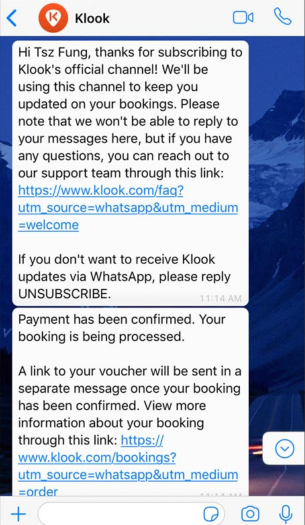
Netflix – personal recommendations
The streaming giant, Netflix, knows a little something about keeping its users engaged with the service. The service offers personal recommendations in its mobile application. In 2017, the company decided to extend this practice to WhatsApp.
Netflix launched this campaign in January 2017 in India – WhatsApp's biggest market. Users, who had both Netflix and WhatsApp installed on their smartphones, saw the offer to stay in touch through WhatsApp messenger. If a person clicked “I’m in,” they started to receive messages about their account and TV program and film suggestions. Half a year after Netflix offered the same opportunity for its users in the UK.
The trick here was to keep interacting with customers even after they’ve canceled their Netflix subscription. New show announcements and reminders triggered recipients to resubscribe to the streaming platform.
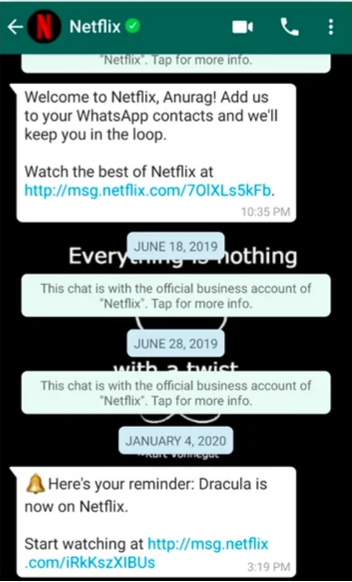
Agent Provocateur – profound counseling
The upmarket lingerie brand, Agent Provocateur, decided to go a bit further with recommendations to customers. A couple of years ago, the company started its Ménage à Trois campaign dedicated to Christmas.
Agent Provocateur offered couples to start a group chat with the brand assistant on WhatsApp. During the conversation, the company representative gave personal recommendations and facilitated the discussion of what the prospects wanted for Christmas.
31% of these conversations resulted in in-store visits and 61% converted into website traffic. The campaign was so successful that Agent Provocateur decided to make Whatsapp counseling a permanent service for VIP customers.
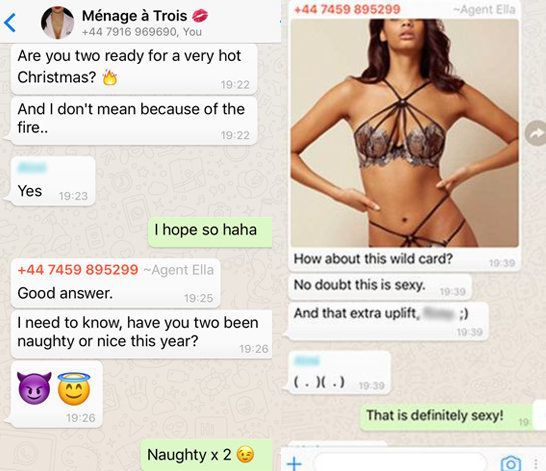
Saffola – real-time help
If you've tried any diet, you are probably familiar with the cravings for a slice of pizza or a cookie. The Indian healthcare brand, Saffola, decided to build its campaign around fighting this want for unhealthy food.
To help people combat their harmful eating habits, Saffola crafted a WhatsApp chatbot. A user could send a message to this bot when they felt a longing for some comfort food. In turn, the chatbot tried to distract a person with pre-recorded positive reinforcements, puzzles, and even a rap song. The latter promoted Suffola’s new active slimming drink.
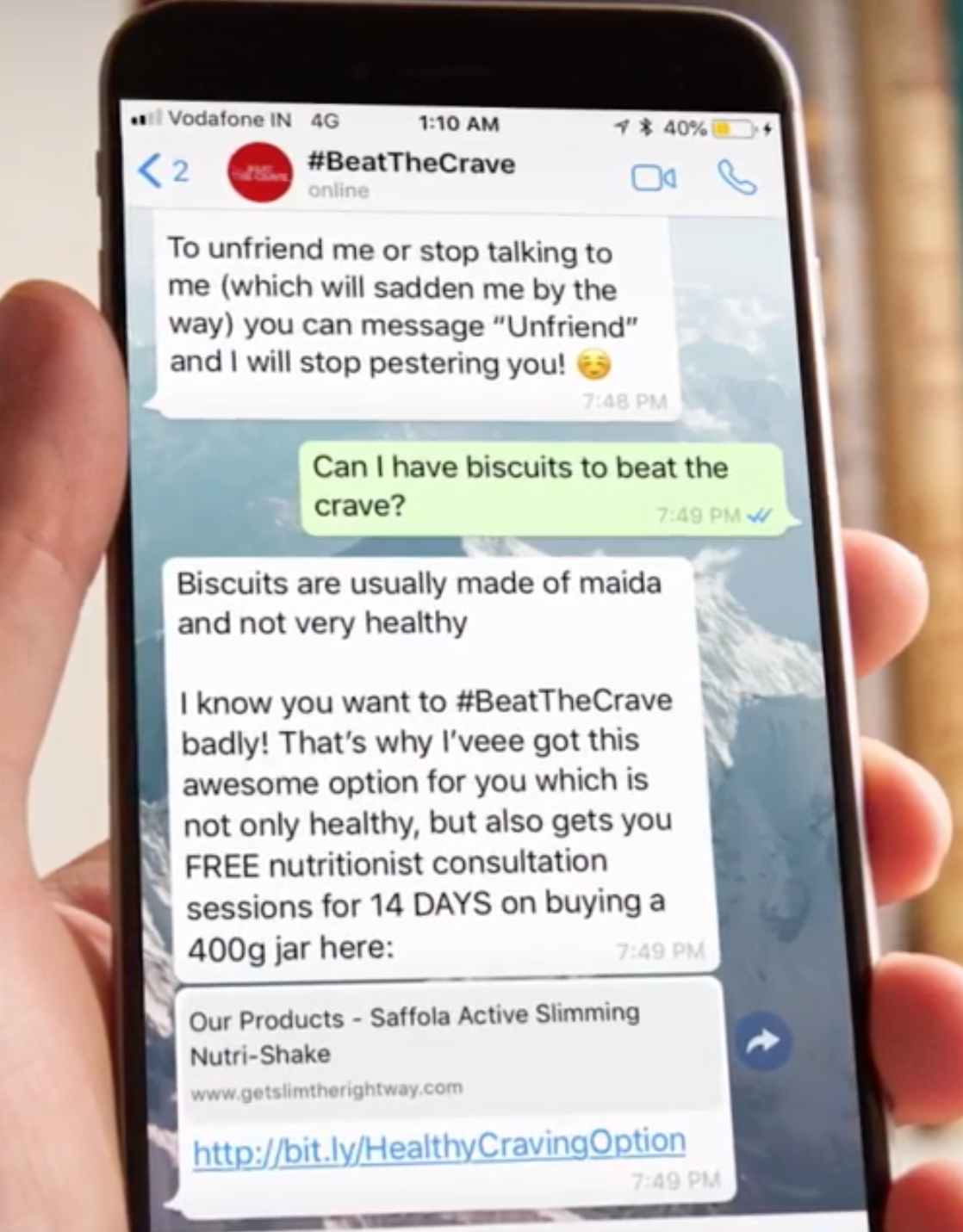
Adidas – tackling audiences’ issues
The sportswear brand, Adidas, used WhatsApp as a part of its new shoe promotion campaign. The brand decided to focus on a narrow audience – amateur football players – and help them tackle their specific issue.
Football teams fairly often experience troubles with stuff. Some players may drop out at the last minute before a match, and there might be no replacement. Adidas offered to find a substitute through WhatsApp. All you need to do is send a message to a WhatsApp hotline and share essential information about the match. In return, Adidas will send a top-notch football player to your game.
Although the campaign only lasted for six days and targeted a specific audience, it has delivered impressive results. In particular, Adidas got a lot of buzz in football media, retail websites, blogs, and so on.
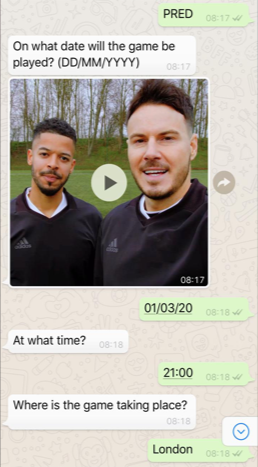
Some of these examples are simple yet effective, while others are difficult to recreate. However, they illustrate the main rules of successful marketing: listen to your audience and know their needs, provide value, and be creative. Want to learn more WhatsApp hacks? Read further.
5 WhatsApp Marketing Tips
- Create broadcast lists
- Use group chats
- Employ WhatsApp statuses
- Craft a product catalog
- Create a WhatsApp link
We’ve unpacked quite a few tricks of building a WhatsApp marketing strategy. Now it’s time to explore some more specific techniques.
Create broadcast lists
In a nutshell, a broadcast list is a group of recipients gathered together. Сontacts can not see each other and receive your messages separately, which makes them similar to segments in your mailing lists.
These peculiarities make broadcast lists the perfect feature for sending relevant campaigns. For instance, you can gather all your VIP customers in one list and send them exclusive offers or ask existing clients for referrals, and so on. Use this feature to retain and engage your audience.
Use group chats
This feature resembles the previous one at first sight, but there’s a difference between them. Unlike broadcast lists, group chats allow members to see each other and share their opinions with the whole group.
So, group chats may come in handy if you want to encourage discussions between your customers. For instance, you may set up a group to warm up participants before some offline event or webinar.
Another case is when your clients make purchasing decisions in groups. It’s a common practice for businesses with elaborate and expensive products, such as IT solutions, industrial equipment, and so on. Although consumer good sellers may benefit from this tool as well – remember the Agent Provocateur example.
Employ WhatsApp statuses
If you're familiar with Facebook or Instagram stories, WhatsApp statuses may ring a bell for you as well. This feature allows you to share text and multimedia files with all your contacts and receive their feedback. While publishing the update, you may also share it on Facebook. The status expires in 24 hours.
In Instagram marketing, stories are one of the most effective tools, and WhatsApp statuses work well too. You can use them to share special offers, product updates, promo codes, and so on. For instance, you may set up a one-day flash sale for WhatsApp users only.
Craft a product catalog
In 2019, WhatsApp launched product catalogs that allow you to showcase your products. The feature has great potential – even Instagram launched the analogous tool called the Instagram shop.
You can add up to 500 items to your WhatsApp product catalog. Your potential customers may browse through it and share links to some products or ask you questions about them. You may also send catalog items to WhatsApp users or share a link to the whole showcase anywhere online. Catalogs are extremely helpful for small businesses or aspiring entrepreneurs with no websites.
Create a WhatsApp link
It might be difficult for users to initiate conversations with brand on WhatsApp since they need to find your phone number, save it, and start a chat. Luckily, there's an awesome solution — A whatsApp link. You can create such a link and place it on your website, in chatbots, landing page, or add it to your email campaigns. To start communicating with your brand, a user only needs to click it, and they will see a pre-made message. With the SendPulse WhatsApp link generator, you can create such a link in several minutes and absolutely for free.
WhatsApp marketing is a golden opportunity to reinforce your brand and build deep, long-lasting relationships with customers. To achieve better results, go beyond WhatsApp and master all the channels your customers prefer. Try Facebook and Telegram messages as well, and reinforce your marketing strategy with email and web push notifications campaigns. To get started with these channels, sign up with SendPulse.
Last Updated: 28.09.2024


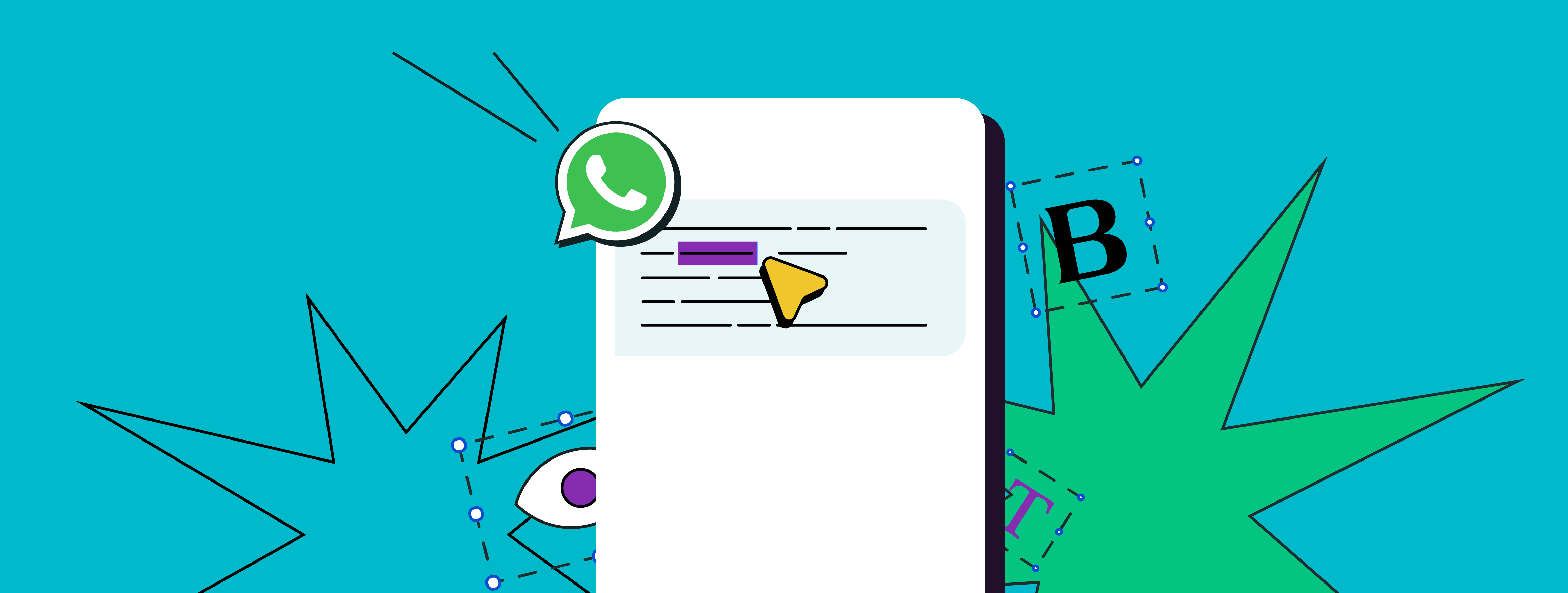
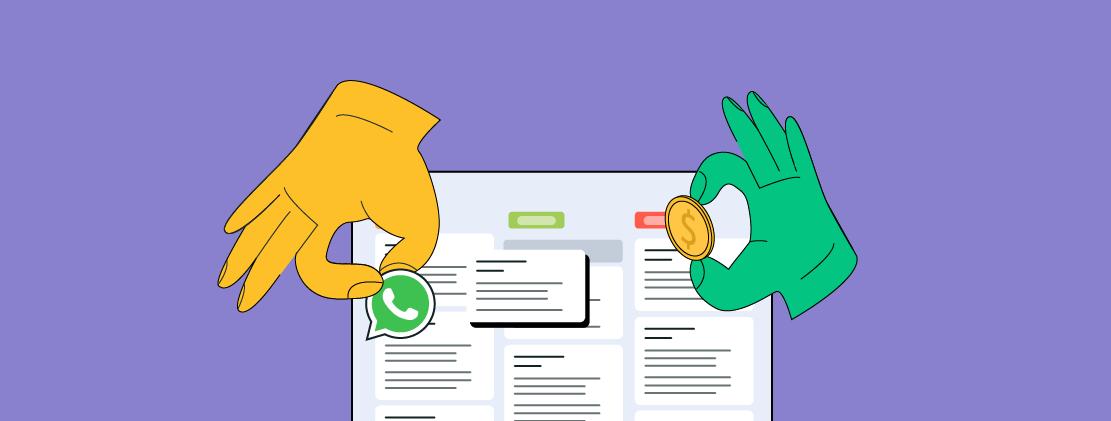
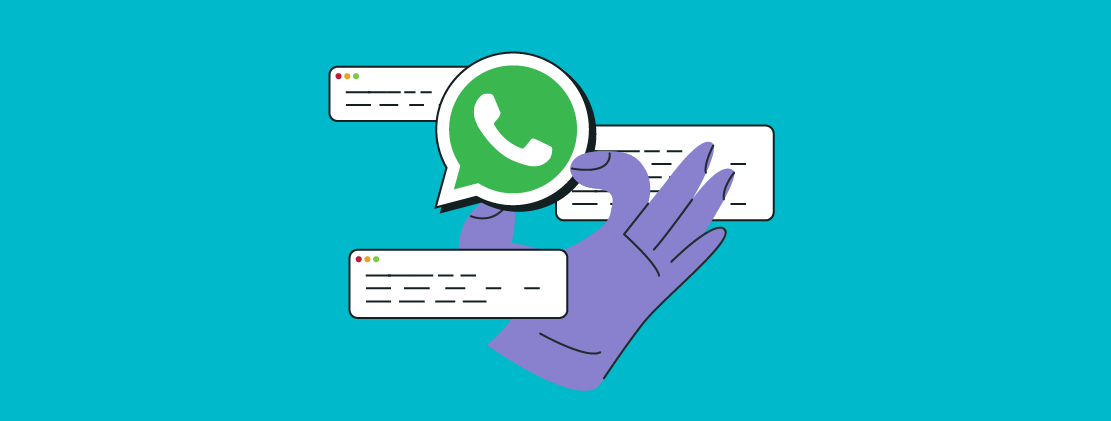
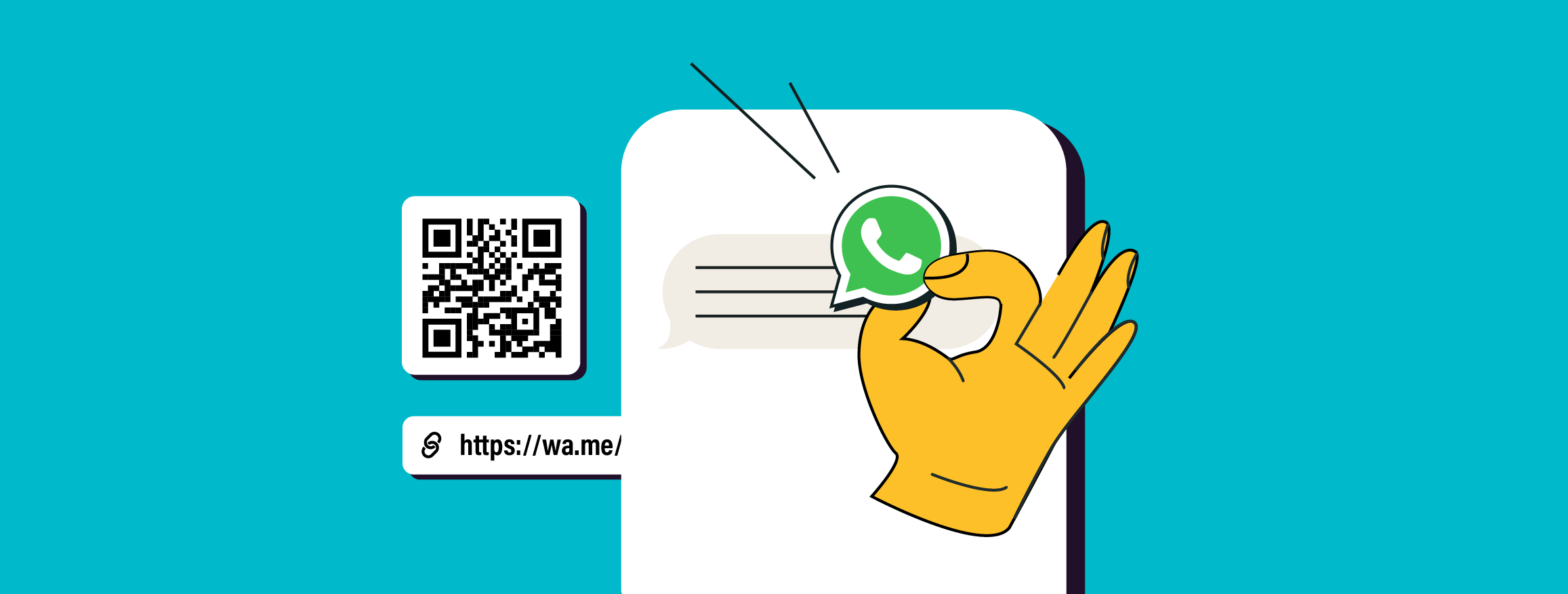
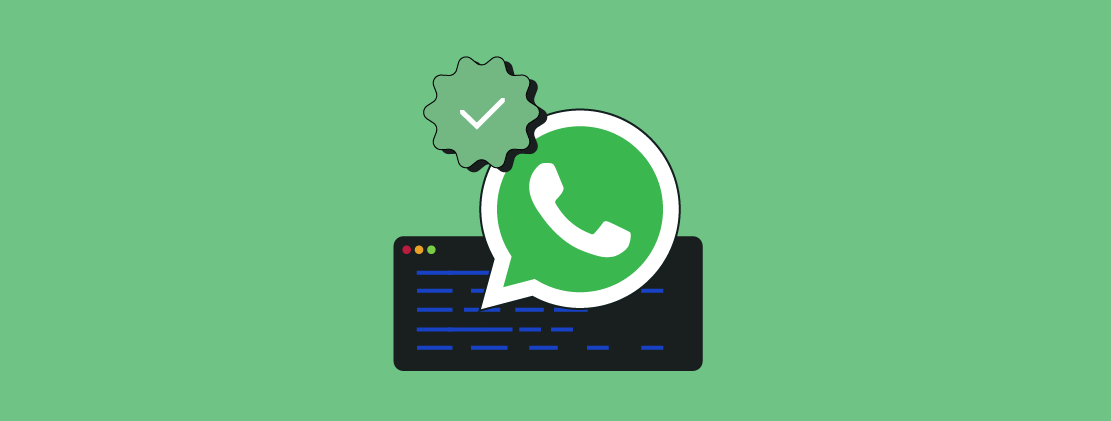
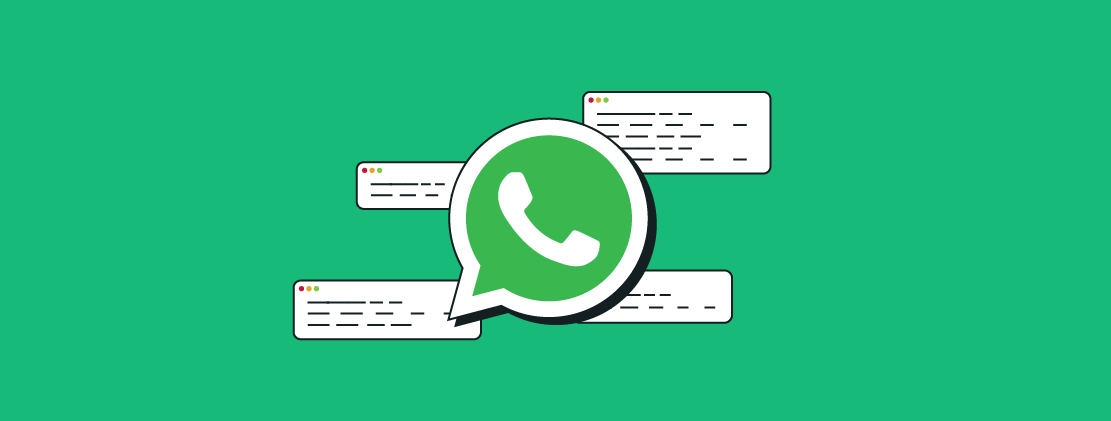
or